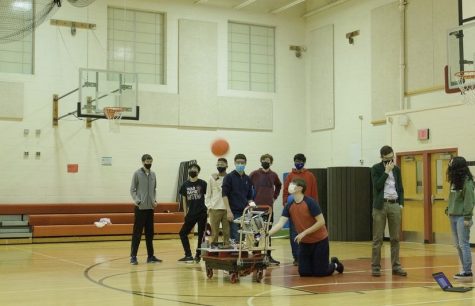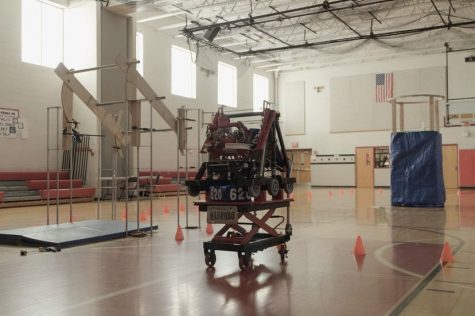Madison Warbots code against competition
March 29, 2022
The Warbots, Madison’s robotics team, are currently gearing up for another year of competition. The team begins their practices in January, ultimately leading towards multiple competitions where they showcase a robot which they built, programmed and designed.
Every year, the team is given a certain game with challenges which they must design their robot to complete. The organization For Inspiration and Recognition of Science and Technology (FIRST) decides what these challenges will be and facilitates the competitions.
Once the team knows what their robot must accomplish, the Warbots begin with brainstorming and design, using a software called Computer-Aided Design (CAD) to lay out the basics of what their robot will look like and how it will accomplish its goals. The rest of the process is completed by specific groups, each with different roles in the robot’s creation.
”We have a drive group, which basically drives the robot when it’s done,” Alex Ying (’23), the team’s co-president, said. “We have programming, who programs the robot, then electronics does the wiring, and mechanical design does the hardware of it.”
Ben Curby (’23) is one of two mechanical leads for the Warbots. He works primarily to build and design the team’s robot.
“Once we got the challenge we spent around a week just coming up with designs and figuring out what we were going to do and how we were going to do the challenge,” Curby said. “Then we started making prototypes […] We spent a couple weeks getting all the parts, putting it together, and wiring everything up as we built it.”
For this year’s competition, the robots must be able to shoot balls into a ring in the center of the arena, and later traverse bars in the air, similar to monkey bars. So far, the team has designed and built their robot, and it has the ability to drive and shoot balls at targets.
Once everything is completed, the team heads off to multiple different competitions beginning in early March. If they do well enough, they can advance to higher levels of competition, including Districts in early April followed by World’s, which is held in Texas.
At these competitions, they are assigned to be in an alliance with two other teams. They go head-to-head with another alliance in three-and-a-half minute rounds, both aiming to accomplish the challenges in the same arena at the same time.
“The first 15 seconds (of the round) are autonomous, meaning the robot has to move without drivers controlling it,” Curby said. “The rest is tele-operated, where the drivers control it using what’s basically an XBox control.”
This year’s competition will be the Warbots’ first in-person competition in two years due to COVID-19. Last year’s entire season was online, and the team held virtual meetings to teach new members basic knowledge for building and designing the robot. Being online led to changes in what they could accomplish as a team and how they could compete.
“Our competition was completely shut down last year from what I remember,” Stuart Ludlum (’23), a co-mechanical design lead, said. “We did not build a robot, we spent most of our time just trying to build up experience in our members and expose them to the tools they would need to succeed in a normal season.”
Although this year the competition is back in-person, teams can only send a limited number of members. At least one person from each different design group will be in attendance to help fix the robot if it breaks during competition.


Even with the difficulty of the past couple of years, the Warbots have adapted well to the challenges and are excited to be back working as a group in person.
“The group dynamic of the whole team is very hectic but fun at the same time,” Thomas Weinhardt (’23), the team’s programming lead, said. “We all have different roles to play but all have the same goal. We all know how to do our specific roles very well so when we come together and make the robot it ends up working well overall.”
Overall, the Warbots enjoy getting to work as a team on something so impressive and rewarding, and get to see their talents put to work in unique and exciting ways.
“I remember at the beginning of the season, some people were writing calculations on a board and I had just learned about those specific things about a week ago in Physics class,” Ying said. “So I love how they sort of tie in […] It’s really interesting how you can see what you’re learning in school and put it into something that you’ve actually worked on.”
The Warbots had their first competition on Saturday, March 5.
“It went incredibly,” Abigail Anton (’23), an electronics lead, said. “We were second best in the district and had one of the most reliable climbing mechanisms. It was stressful in many ways and we’ve made tons of changes to the bot since, but I’m very happy with how we did.”


